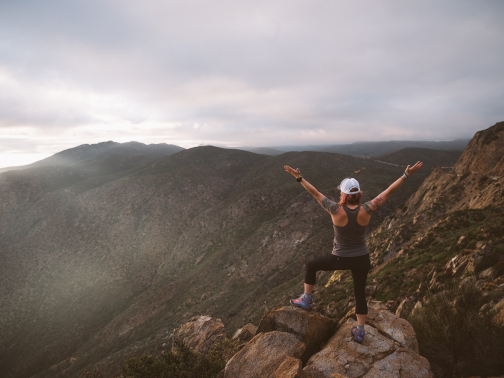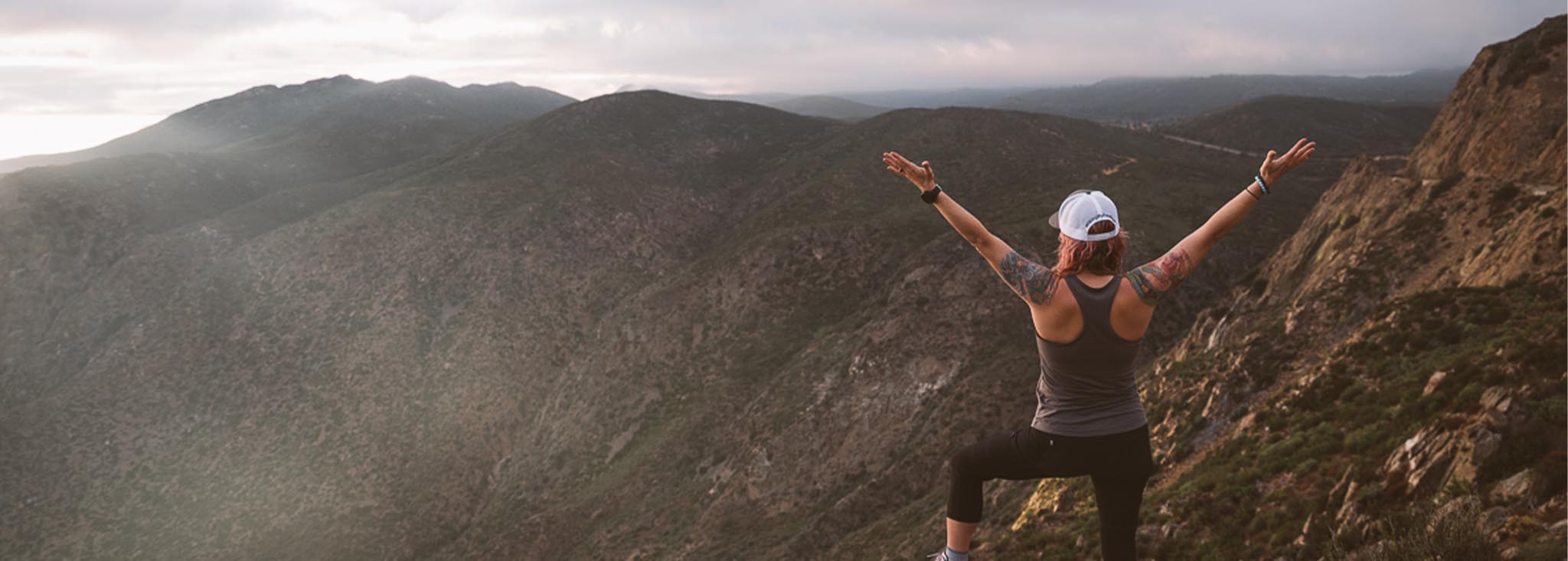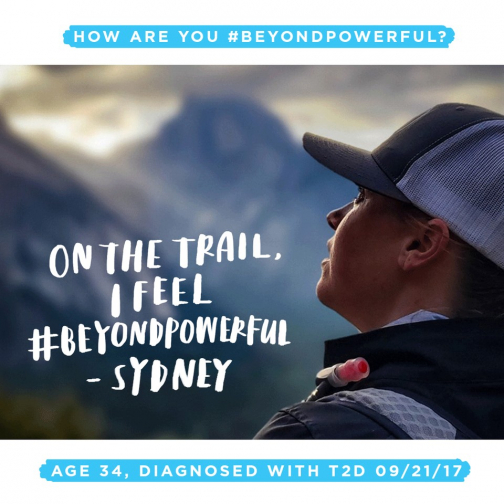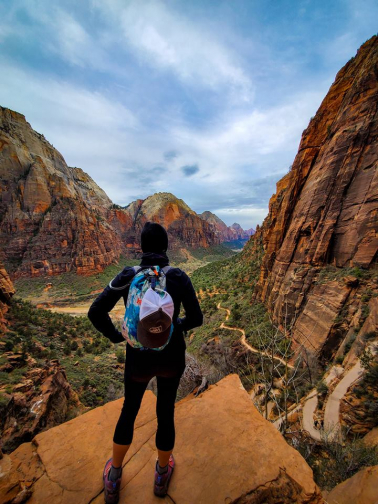Hiking My Feelings to Manage Diabetes
Editor’s Note: Get involved in Beyond Type 2’s #SeeTheSigns of diabetes campaign! Share your signs to help save lives, get sharable graphics for social media and more! Learn more here.
Sydney Williams has been living with type 2 diabetes for over two years. Her love for hiking forced her to confront some deep feelings about her relationship with food, exercise and herself. This led to her going on a national tour to talk about the impact hiking has had on her life.
In our discussion with Sydney, she talks to us about toxic people-pleasing, addressing mental health and the importance of recognizing the impact of self-talk. Sydney has also been featured in our #BeyondPowerful campaign on social media, where we feature stories of anyone living with type 2.
When were you diagnosed with type 2 diabetes? What was your reaction?
I was diagnosed with diabetes in September 2017. Leading up to my diagnosis, I was really thirsty and experienced some pretty weird gastrointestinal issues. I had gone out for a really long paddleboarding session a few weeks prior to my diagnosis and I figured my thirst and fatigue were tied to that.
While driving to the airport to pick up a friend, the hospital called with my test results, so my first thought was “don’t wreck the car” followed by tears. My next thought was “well, I guess I can’t eat bread anymore?” I didn’t know anything about diabetes other than the memes and jokes. I didn’t know what was happening in my body, I didn’t know if this was something I could fix.
What changes did you make to adjust to this chronic illness?
As part of my first steps to making changes, I started by adjusting my nutrition and exercise routine. I was walking 30-45 minutes every morning and was on metformin twice daily. I’ve always had a disordered relationship with food, and I trace that back to a comment my mother made when I was young. She pulled me aside when I was younger and told me “you gotta watch what you eat, or you’ll end up like me.” Since then, I was terrified of being fat, and I did everything I could to be smaller, to take up less space, to get closer to my “dream” body.
I had restricted so much for so long. Around 2015-2016, I decided not to restrict myself anymore. This, coupled with coping mechanisms like eating and drinking my feelings, led to a 50+ pound weight gain in just a couple of years. In the years leading up to the diagnosis, I had stopped chasing that “perfect” body and started to love the body I have.
After my diagnosis, I knew what I needed to do. I’ve always been pretty athletic and I know what kinds of food makes my body feel happy and healthy, so it was literally like flipping a switch—I knew what I needed to do, I trusted that I could do it and then I went and made the changes
Does diabetes run in your family? What kind of support did you find?
I believe my parents are pre-diabetic, but I didn’t get support from them. My support came from my husband, who jumped right on the bandwagon with me. Every single change I made in my life, he made in his. It is so important to have the full support of the people around you in order to manage this disease effectively.
Tell us about Hiking My Feelings. How has it helped you manage diabetes?
Hiking My Feelings was born out of a realization on a training hike during my preparation for my second trek across Catalina Island. I was at the summit of Stonewall Peak outside of San Diego, CA and I was so relaxed. And I shouldn’t have felt relaxed, not by any “normal” standards. I was a recently diagnosed person with diabetes who just quit two jobs in the span of five months, a now unemployed former breadwinner for our family, with nothing else lined up. I should be stressed, right? In times like these, when life had dealt a bad hand in the past, I would jump into a pint of ice cream or drink a whole bottle of wine to myself. When I got diagnosed, I channeled my notoriously toxic people-pleasing tendencies into being the best diabetes patient my doctor has ever seen. In doing that, eating ice cream for breakfast and a bottle of wine to myself every night couldn’t be part of my life anymore. So I realized I had been hiking my feelings instead of eating and drinking my feelings. That felt like a revolutionary shift for me, and I still wasn’t satisfied. I wanted to know why I was eating and drinking my feelings, to begin with. Though these behaviors are socially acceptable in this country and are normalized in TV, movies, books and magazines, where did they come from? Why had I been doing that?
 As I hiked across the island the second time, I hiked some serious feelings. Over the course of six days, I processed the trauma of losing 23 friends in four years, reclaimed the parts of my body that people said were bad or wrong or gross—parts of me I had been striving to change to meet a very narrow standard of beauty in this country and went face-to-face with my inner critic to leave all of my doubts, expectations, fears and projections out on the trail. In doing so, I connected the dots between a sexual assault I survived 13 years ago and how the unresolved trauma from the assault manifested in my body as a physical and mental disease. At the end of the hike, I came to understand this beautiful metaphor for all of the hard things I had survived. I realized I’ve been walking through life with this invisible backpack on, and it’s full of my trauma. I lovingly call it my “traumapack,” and over the course of the hike across this island, I was unpacking it.
As I hiked across the island the second time, I hiked some serious feelings. Over the course of six days, I processed the trauma of losing 23 friends in four years, reclaimed the parts of my body that people said were bad or wrong or gross—parts of me I had been striving to change to meet a very narrow standard of beauty in this country and went face-to-face with my inner critic to leave all of my doubts, expectations, fears and projections out on the trail. In doing so, I connected the dots between a sexual assault I survived 13 years ago and how the unresolved trauma from the assault manifested in my body as a physical and mental disease. At the end of the hike, I came to understand this beautiful metaphor for all of the hard things I had survived. I realized I’ve been walking through life with this invisible backpack on, and it’s full of my trauma. I lovingly call it my “traumapack,” and over the course of the hike across this island, I was unpacking it.
Now, Hiking My Feelings is the name of my book, my speaking + hiking tour, and the movement we are leading to encourage folks to get off the couch and onto the trail. We know that as individuals and communities, we are affected by trauma. As we’ve been traveling around the United States this year, we see how this trauma is manifesting as a physical and mental disease. And of course, thanks to my experience on the trail, we know that spending time outdoors can help us heal.
For those who want to begin hiking to improve their health, how can they get started?
Here’s the secret about hiking—it’s just walking. Sometimes it’s walking uphill, sometimes it’s flat, sometimes it’s downhill, but really, you’re just walking. So if you have never set foot on a trail before and you aren’t sure where to start, start with walks around your neighborhood. That’s what I did. I set my alarm in the morning, and before I even picked up my phone to check my notifications, I was out the door and walking. When we roll over and grab our phones, we can get sucked into the vortex of emails, social media and cute animal videos before we take care of ourselves.
I started with 30-45 minutes around the neighborhood every morning and when that got to be too “easy”—then I graduated to local trails. I highly recommend the AllTrails app—you can download it, open it up and it will use your location to locate trails around you. On tour this year, we hiked with a woman in Fort Worth who had been living there for 15 years and had no idea that there was an entire trail system five minutes from her house. Start there to get an idea of what’s available to you.
If you do some research about what kind of equipment you need for a hike, you’re going to see a lot of lists with a lot of expensive gear. To get started, all you really need to get started is a good pair of shoes, a water bottle and your brain. Go out for a shorter hike, and if you can, grab a friend to go with you. See if you like it. If you do, then start planning to acquire some of the recommended gear. A lot of outdoor equipment stores are doing equipment rentals as well, so you can try before you buy.
As you graduate to local trails and longer hikes, then yes, you’ll want to get a nice backpack designed for day hiking and some additional equipment to keep with you in case of an emergency in the wilderness. But you definitely don’t need ALL THE THINGS to start walking around your neighborhood.
What are some misconceptions about type 2 diabetes people have?
I can only speak from my own experience, but there seems to be a lot of shaming around type 2 diabetes. Since it can be managed via diet and exercise, there is this feeling that if you have it, you brought it upon yourself. And to some extent, that is true and I had to really sit with that for a bit. At the end of the day, I can’t cut diabetes out of me. Only I can move my body and only I can decide what I consume. I have to make healthy choices every day to keep this disease under control. However, the part of the conversation that is missing is how political this disease is. Yes, it is preventable with proper nutrition and incorporating exercise into your life, and yes, it can be reversed if you catch it early and manage it effectively, but we never talk about the barriers some folks face in those areas. When people say “it’s a choice to eat healthily and move your body” that leaves no room for the understanding that yes, it is a choice, but we are all born on different foundations from which to make choices.
When I was diagnosed, I was living in San Diego, making $118,000 a year, had platinum health benefits from my employer, unlimited vacation/sick time and my boss who was a compassionate human being. I had the opportunity and support to make the choice to aggressively manage this disease.
If I lived in a food desert or if I couldn’t afford whole, healthy foods, it would have been much more difficult to manage my nutrition plan. If I didn’t have health insurance, I wouldn’t have been diagnosed. If my insurance plan didn’t cover lab work or if my copay was outrageous, I wouldn’t have been able to afford basic diagnostics. If I had to choose between getting paid or getting healthy, I wouldn’t have been able to take the time I need to manage my health. If my boss was strict about my working hours and didn’t have the emotional intelligence to know that I needed to shift my schedule to prioritize my health, I would have had even more stress to deal with on top of learning how to live with a chronic diagnosis. We have to talk about the social, political and economic barriers to success in managing this disease when we talk about diabetes, or else the conversation is incomplete.
Finally, what are some words of empowerment you have for our audience?
Whether you were recently diagnosed or if you’ve been living with pre-diabetes or type 2 diabetes for a while now, I encourage you to look at this disease as an opportunity versus a burden. If you’re like me and you’ve had a desire to get healthy for a long time but were always struggling, use diabetes as your opportunity to choose differently. The four factors that affect our blood sugar— food, exercise, medicine and stress—is a beautiful checklist to reconnect with yourself every time you check your blood sugar. If your readings are coming back high, scan the four factors—what did I eat? Did I move my body? Am I taking my medications as prescribed? Am I stressed?
I had spent my whole life trying to eat right and move my body in ways that promised results, but yet I couldn’t ever achieve my goals. It wasn’t until I started addressing my mental health that my physical health followed. Our brains are so powerful, and if we don’t consciously pay attention to how we talk to ourselves and the information we consume, we can quit before we even start. For me, getting out in nature was where I saw the best results. You don’t have to go hike across a whole island, but do give yourself the gift of disconnecting from your devices and distractions and reconnecting with yourself. Start with that 30-minute walk every morning. That is your time, without your phone, without the outside forces that try to steal your attention. Honor that time, protect that time. Pay attention to the thoughts and memories that come up for you while you’re walking, and notice what you feel in your body and where you feel it. We spend a lot of time living in our heads, looking outside ourselves for validation because we are trained to seek an authority figure to trust before we trust ourselves.
This disease is the best thing that ever happened to me because it created the space I needed in my life to truly get back to myself, so I could take care of myself. And if you’re used to taking care of everyone else before you care for yourself, this transition can feel selfish. I urge you to resist the distractions, these internalized beliefs that we are not worthy of caring for ourselves, because we are. When we stop putting everyone else first and take care of ourselves, we can find health and happiness. When we put on our own oxygen masks first, we can help the people around us. When we heal our wounds, we can show up authentically in community with other people, and the folks around us are positively impacted by the work we’ve done, and they want to make those changes for themselves. This is the ripple effect I believe we can all be a part of, and it has to start with us.
Where can our audience get in touch with you and learn more about Hiking My Feelings?
Thank you for the opportunity to share a bit of my story! I’m stoked to share that my book, Hiking My Feelings: Stepping into the Healing Power of Nature is now available for pre-order and in 2020, we’ll be doing another tour around the US to encourage more folks to get off the couch and onto the trail with us. You can check our tour schedule and order the book at hikingmyfeelings.com. Join the conversation by following us on Instagram (@hikingmyfeelings), and when you start hiking, be sure to tag your posts with #hikingmyfeelings—we’re excited to support you on your healing journey!







